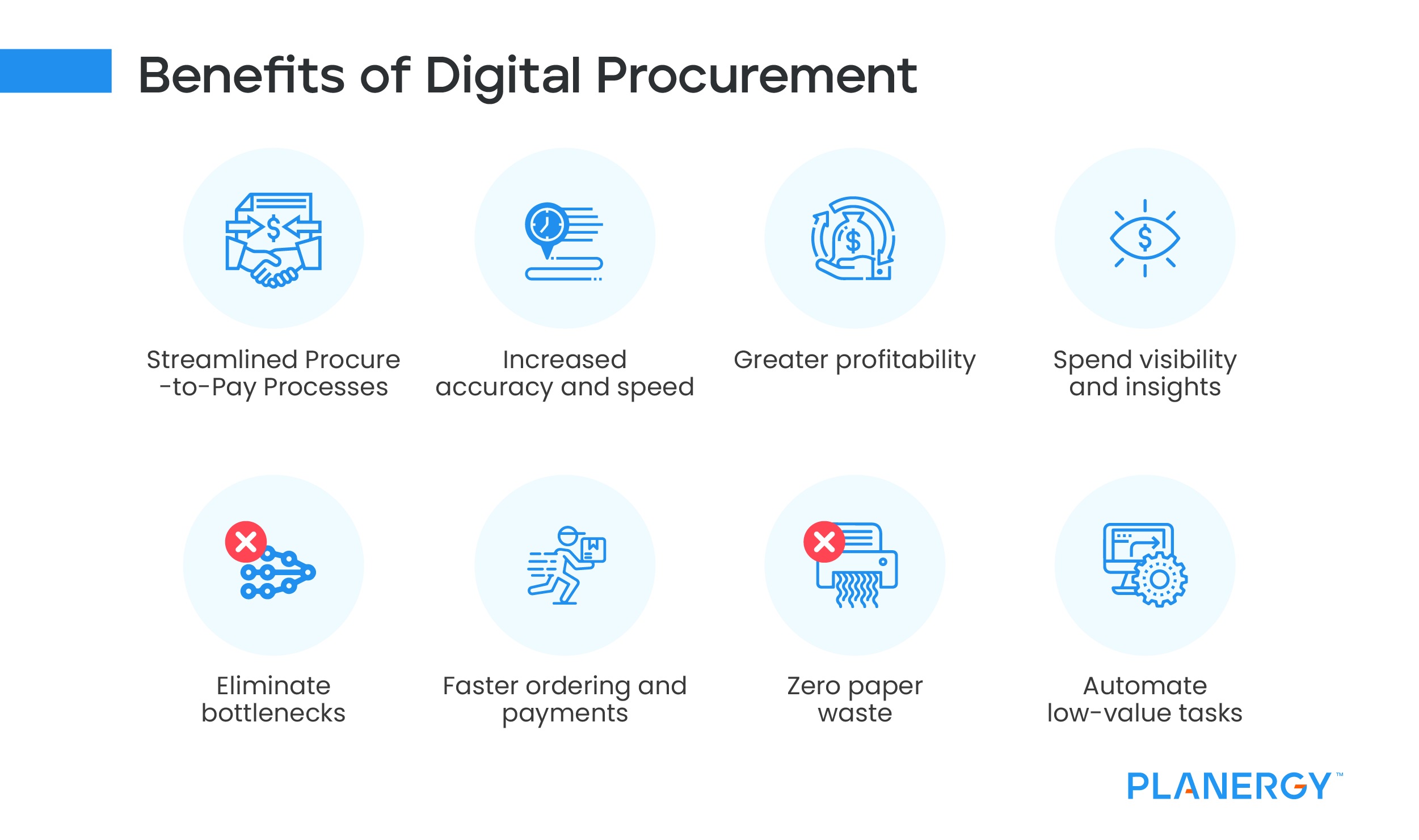Does your business have what it takes to compete in a global economy that’s increasingly adopting digital technologies? If you haven’t yet made digital transformation part of your procurement strategy, you might find yourself playing catch-up with your competition.
Procurement is one of the most effective and profitable places to begin your digital transformation journey.
Implementing a digital procurement platform can have a powerful and immediate impact on your company’s financial health and competitive agility—provided it’s done strategically.
Taking the time to familiarize yourself with digital procurement, why it matters, and what to look for in a digital procurement platform can help your company achieve true digital transformation. The result will be an increased ability to compete and innovate for years to come.
What Is Digital Transformation in Procurement?
Digital transformation in procurement is the transition from siloed, paper-based, and manual procurement processes to digital, automated, and integrated business processes.
It uses digital platforms to connect the procurement function with the whole business and centralize supplier, category, and contract management.
It also connected procurement more closely to accounts payable in a process called closed-loop spend management. In this system, the entire procure-to-pay process is connected to provide a more holistic view of a company’s spending patterns.
Digitally transformed procurement departments using a closed-loop system find useful spend insights in real time. On the contrary, teams that use manual and paper-based systems end up with scattered data that makes finding actionable insights difficult and slow.
The difference between digital procurement and digital transformation in procurement is that digital procurement refers to using software to complete the procurement function while digital transformation refers to migrating from outdated manual processes to modern digital ones.
Digitally transformed procurement departments using a closed-loop system find actionable spend insights in real-time. Teams that continue to use manual and paper-based systems end up with scattered data that makes finding insights difficult and slow.
What Is a Digital Procurement Platform?
Digital procurement platforms are software systems that focus on automating and streamlining the procurement process. They proactively focus on generating savings, innovation, and value by transforming the procurement function from manual to digital.
Digital procurement systems typically employ artificial intelligence, advanced data analytics, and process automation to streamline and automate procurement processes.
Procurement organizations are tasked with managing spend, supply chains, and supplier relationships.
Digital procurement is used to transform these three functions to maximize their effectiveness and introduce new benefits, such as innovation, improved strategic planning, and decision-making.
Digital procurement solutions centralize and streamline your entire software environment, and connect to your existing enterprise resource planning (ERP), accounting, marketing, and other software to both improve data quality and provide a more intuitive user experience for your team.
What Are the Benefits of Digital Procurement?
The benefits of digital procurement stem from maximizing value and finding efficiency throughout the supply chain. The larger and more complex a company is, the more they have to gain from digital procurement.
A Bain & Company study found that switching to digital procurement could save Global 5000 companies nearly $86 billion per year. That translates to an average savings of $12 million for companies spending between $1 billion and $3 billion annually, and $27 million for companies spending more than $3 billion.
The benefits of switching from manual and paper-based procurement processes to digital procurement include:
- A streamlined procure-to-pay process with increased accuracy and speed
- Higher profitability through cutting cost-draining manual processes
- Greater spend visibility and insights through analytics and reports
- Access to the best prices through early payment discounts
- Eliminate bottlenecks through automated approval workflows
- Zero paper waste and less frustration
- Staff are freed up for more valuable tasks

What the Best Digital Procurement Software Should Provide
When evaluating digital procurement software, it’s good to know what technology is established and what’s cutting edge.
Established technologies are the baseline that all digital procurement tools should have, but some also have evolving and emerging technology that can offer more. What you choose will depend on your level or need.
Established Technologies
These tools are already in widespread use and considered standard components of digital transformation in general and procurement transformation in particular.
They include:
- eProcurement
- Procure-to-pay process automation
- eSourcing
- Contract management
- Guided buying/electronic catalogs
- Supplier relationship management
- Category management
- eInvoices and accounts payable automation
- Electronic bidding (eAuctions)
- Spend analytics
Evolving Technologies
These tools are not yet universal but are leveraged by best-in-class procurement organizations to further enhance performance, savings, and value generation.
They include:
- Advanced artificial intelligence and machine learning
- Advanced predictive data analytics
- Advanced data visualization (basic virtual reality)
- 3D printing for modeling/prototyping
- Intelligent content extraction
- Software and hardware robotics
Emerging Technologies
These tools have strong potential for future value creation and procurement innovation.
They include:
- Internet of Things technologies (e.g., sensors, cyber tracking, wearables)
- Advanced virtual reality and spatial analytics
Digital procurement platforms allow chief procurement officers (CPOs) and other procurement professionals to optimize their operating models with a blend of these technologies.
Procurement organizations are built on managing spend, supply chains, and supplier relationships. Digital procurement transforms these three functions to maximize their effectiveness and introduce new benefits.
How Digital Procurement Optimizes Three Primary Procurement Functions
When building an effective procurement strategy, outdated models and manual workflows will not allow you to stay competitive.
The new generation of procurement tools help you meet and overcome the most common procurement challenges more effectively than ever before.
Digital procurement positively impacts each of the three primary procurement functions; strategic sourcing, procure-to-pay, and supplier management.
Strategic Sourcing
When optimized through digital procurement, strategic sourcing (a strategy around vetting and selecting suppliers) ensures your supply chain supports a healthy and streamlined value chain.
Digital procurement supports strategic sourcing by ensuring it:
- Is proactive, secure, and focused on protecting both supply chain resilience and business continuity.
- Can be managed in real-time, improving decision-making, budgeting, and both short- and long-term spending plans.
- Uses advanced analytics to predict both demand and future sourcing opportunities to seize discounts, cut costs, and mitigate disruptions.
- Uses intelligent contract management to notify the procurement team of opportunities to revisit and adjust existing agreements—or make new ones—to take advantage of changes in market conditions and supplier status.
- Uses spend analytics to identify opportunities for cost savings through measures like supplier consolidation and negotiation.
Procure-to-Pay (P2P)
The backbone of your procurement process, P2P touches all your transactions, from the purchase order to the final invoice and payment.
Digital procurement streamlines every step of the P2P lifecycle, improves user experience, and eliminates human error while improving productivity and reducing risk.
With digital procurement technology, P2P is:
- Much faster and more accurate through process automation.
- Less dependent on the need for human intervention in high-volume, repetitive tasks—reducing the potential for human error.
- More secure and accurate through automatic three-way matching, support for electronic invoicing (eInvoicing), and automatic payments based on criteria set by your team.
- More proactive, with support for automatic re-orders based on demand and spend analysis.
- More cost-effective by eliminating the need for paper documents (and storage).
- More intuitive and user-friendly, with guided buying and integrated contract, supplier, and inventory management modules sharing data in real-time.
- More secure; automation and closed buying environments reduce the risk of both maverick spend and invoice fraud.
- More compliant, enforcing procurement policies and strategic business policies like ESG.
Supplier Relationship Management
The relationships you build with suppliers can help you take advantage of opportunities you might not otherwise have—and provide the insights you need for supplier risk management.
Digital procurement makes it possible to form, track, and manage supplier relationships in a collaborative and strategic way.
It makes it easier to compete effectively through strategic sourcing and helps identify new opportunities to generate value, capture savings, and form partnerships with your best suppliers.
Proactive procurement teams use digital procurement to:
- Simplify vendor evaluation, onboarding, and review through the use of vendor portals.
- Monitor supplier risk and performance through integration and analysis of multiple data sources.
- Leverage vendor data to build new partnerships, develop new products, or break into new markets.
Optimizing your procurement strategy and processes on these three fronts will provide a strong foundation for digital transformation throughout your business as a whole.
The top three challenges companies face in digital procurement are the underutilization of analytics (72%), the inability to accurately gauge supplier performance (64%), and the underutilization of automation technologies such as robotic process automation (52%).
How To Create a Digital Procurement Roadmap
Your procurement challenges will be unique to your business. Your plans for procurement transformation will need to reflect the priorities of your business.
However, you can chart a path to long-term digital transformation success by drawing up a procurement transformation roadmap and following a few best practices.
Perform Needs Analysis
Understanding your current procurement capabilities and limitations is the first step to improving and overcoming them.
Start with a needs analysis to identify the areas of procurement most in need of immediate digital transformation, and determine the resources you need—time, money, training, cultural and infrastructure transformation, etc.—to make those changes happen.
According to a 2019 CPO survey, the top three challenges companies face in digital procurement are underutilization of analytics (72%), the inability to accurately gauge supplier performance (64%), and underutilization of automation technologies such as robotic process automation (52%).
Some of the areas you might focus on include:
- Optimizing return on investment (ROI).
- Improved inventory management.
- Supply chain quality and resilience.
- Improving spend transparency and accuracy of spend analysis.
- Improving demand forecasting and agility to preserve business continuity and mitigating factors such as seasonality or supply chain disruptions.
- Cultural and educational changes are necessary to ensure compliance, enthusiasm, and even evangelism for the new operating model.
Determine Your Ideal Outcomes
Now that you know where to focus your efforts, determine what you want your results to be.
Look at specific processes you’ll need to change, the pain points you’ll need to overcome, and what you want the results of those changes to be.
In this step, you can focus on things like:
- Determine what specific problems you need to address in your supply chain to make the biggest impact on your business.
- Selecting the key performance indicators (KPIs) to track and set a benchmark you want to achieve.
- Figuring out what technology you can use that will improve your processes and help you get to your desired state.
Map Out Your Strategy
With your needs identified, ideal outcomes determined, and KPIs set, it’s time to map how you will achieve your goals.
Write out the specific actions you will take, the benefit they will provide, and how easy they will be to implement. You can separate these campaigns into short term (3-6 months), medium term (up to 1 year), and long term (more than 1 year).
Lastly, ensure that you’re set up to measure the impact and KPIs of these campaigns after you implement them. Digital procurement software is ideal for capturing these metrics.
Ensure Digital Procurement Buy-In and Investment
Removing the roadblocks created by legacy practices and tools is paramount to your success.
New technology allows procurement teams to begin generating value by spinning data into gold, but often this idea needs to be ‘sold’ to senior executives and stakeholders throughout the company.
Create a ‘spec doc’ that you can share internally with your executives and team to ensure that you get the resources and investment you need to make this transition to digital procurement.
You can show how digital procurement will contribute to the following:
- Process optimization
- Continuous improvement
- Strategic collaboration and supplier relationship management
- Opportunities to develop new products
- Innovations such as internal production of essential components via on-demand 3D printing or improved logistics using the Internet of Things to track orders, payments, and materials.
- Combining a formerly scattered software and data environment to provide fresh insights.
According to a McKinsey & Co report, digital procurement programs create a 40% increase in annual savings and a 50% reduction in value leakage.
Ideally, you can pull some metrics to demonstrate ‘current state’ vs ‘ideal state’ and show the executive the ROI that digital procurement creates for your organization.
Select Your Digital Procurement System
It’s important to carefully select the right procurement software for your needs.
Since you’ve defined those needs in the previous steps, you can create a checklist to evaluate digital procurement systems against whether or not they meet your specific needs.
Choosing a provider like PLANERGY ensures you’ll have not just best-in-class software, but the support you need to help your team master their new procurement platform.
You’ll also get the training and education necessary to achieve buy-in from the C-Suite down.
Deliver and Implement Your Digital Procurement Roadmap
Now that you’ve got your needs, outcomes, strategies, buy-in, and technology all lined up, it’s time to finalize your roadmap.
The final form can be a word document, slides, PDF, or whatever you prefer. The main idea is that it shows off how you’ve carefully decided what problems you want to solve and how you’re going to get there.
Your roadmap might start by automating parts of your P2P process one piece at a time until the entire process is streamlined and efficient. Then, you may start implementing a corresponding set of internal controls for spend management.
Whatever you end up with, your roadmap should be clear and easy for your organization to follow.
Continuous improvement is a key part of digital transformation, including your digital procurement roadmap. Your roadmap can act as a ‘living document’ that can be updated as new information surfaces.
If you find something isn’t working or a new need has come up that you weren’t aware of, change it.
The Age of Digital Procurement Has Arrived
From paying the bills to collaborating strategically with your suppliers, procurement has an important role to play in the health and growth of your business.
Investing in new technology and creating a strong digital procurement strategy can help you lead the pack in the race for a stronger value chain—while ensuring you build a resilient business.




